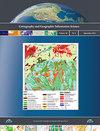Bringing spatial interaction measures into multi-criteria assessment of redistricting plans using interactive web mapping
IF 2.4
3区 地球科学
Q1 GEOGRAPHY
Cartography and Geographic Information Science
Pub Date : 2023-10-17
DOI:10.1080/15230406.2023.2264750
引用次数: 0
Abstract
ABSTRACTRedistricting is the process by which electoral district boundaries are drawn so as to capture coherent communities of interest (COIs). While states rely on various proxies for community illustration, such as compactness and municipal split counts, to guide redistricting, recent legal challenges and scholarly works have shown the difficulty of balancing multiple criteria in district plan creation. To address these issues, we propose the use of spatial interaction to directly quantify the degree to which districts capture the underlying COIs. Using large-scale human mobility flow data, we condense spatial interaction community capture for a set of districts into a single number, the interaction ratio (IR), for redistricting plan evaluation. To compare the IR to traditional redistricting criteria (compactness and fairness), we employ a Markov chain-based regionalization algorithm (ReCom) to produce ensembles of valid plans and calculate the degree to which they capture spatial interaction communities. Furthermore, we propose two methods for biasing the ReCom algorithm towards different IR values. We perform a multi-criteria assessment of the space of valid maps, and present the results in an interactive web map. The experiments on Wisconsin congressional districting plans demonstrate the effectiveness of our methods for biasing sampling towards higher or lower IR values. Furthermore, the analysis of the districts produced with these methods suggests that districts with higher IR and compactness values tend to produce district plans that are more proportional with regard to seats allocated to each of the two major parties.KEYWORDS: Redistrictingregionalizationmobilityinteractive mapspatial interaction AcknowledgmentsWe would like to thank Gareth Baldrica-Franklin and Professor Robert Roth for their help and guidance in the development of the web map. We would also like to thank Professor Jin-Yi Cai for sharing his expertise on modifying the ensemble distribution in algorithmic design.Disclosure statementNo potential conflict of interest was reported by the author(s).Data availability statementThe mobility flow dataset used in this research is publicly available on GitHub: https://github.com/GeoDS/COVID19USFlows and from SafeGraph. The other aggregated data that support the findings of this study are available from the U.S. census bureau. Due to the privacy protection policies of the data providers, the voting data used here are not publicly available.Additional informationFundingThis project is supported by the University of Wisconsin 2020 WARF Discovery Initiative funded project: Multidisciplinary Approach for Redistricting Knowledge. Any opinions, findings, and conclusions or recommendations expressed in this material are those of the author(s) and do not necessarily reflect the views of the funder(s).将空间交互措施引入交互式网络制图的多准则重划规划评估
选区划分是通过选区边界绘制的过程,以便捕获一致的利益社区(COIs)。虽然各州依靠各种代理来说明社区情况,如紧凑性和市政分裂计数,来指导重新划分,但最近的法律挑战和学术工作表明,在制定地区规划时平衡多种标准是困难的。为了解决这些问题,我们建议使用空间相互作用来直接量化地区捕获潜在coi的程度。利用大规模人口流动流数据,我们将一组地区的空间交互社区捕获压缩为一个单一的数字,即交互比率(IR),用于重新划分规划评估。为了将IR与传统的重划标准(紧凑性和公平性)进行比较,我们采用了基于马尔可夫链的区划算法(ReCom)来生成有效规划的集合,并计算它们捕获空间相互作用群落的程度。此外,我们提出了两种方法来使ReCom算法对不同的IR值进行偏置。我们对有效地图的空间进行多标准评估,并在交互式网络地图中呈现结果。威斯康星州国会选区计划的实验证明了我们的方法对较高或较低IR值的抽样偏置的有效性。此外,对用这些方法产生的地区的分析表明,具有较高IR和紧凑度值的地区往往会产生与分配给两个主要政党的席位更成比例的地区规划。我们要感谢Gareth Baldrica-Franklin和Robert Roth教授在网络地图开发过程中的帮助和指导。我们也要感谢蔡金义教授分享他在修改算法设计中的集成分布方面的专业知识。披露声明作者未报告潜在的利益冲突。数据可用性声明本研究中使用的流动性流数据集在GitHub上公开可用:https://github.com/GeoDS/COVID19USFlows和SafeGraph。支持这项研究结果的其他汇总数据来自美国人口普查局。由于数据提供商的隐私保护政策,这里使用的投票数据是不公开的。本项目由威斯康星大学2020年WARF发现计划资助项目:重新划分知识的多学科方法支持。本材料中表达的任何意见、发现、结论或建议均为作者的意见,并不一定反映资助者的观点。
本文章由计算机程序翻译,如有差异,请以英文原文为准。
求助全文
约1分钟内获得全文
求助全文
来源期刊
CiteScore
5.20
自引率
20.00%
发文量
23
期刊介绍:
Cartography and Geographic Information Science (CaGIS) is the official publication of the Cartography and Geographic Information Society (CaGIS), a member organization of the American Congress on Surveying and Mapping (ACSM). The Cartography and Geographic Information Society supports research, education, and practices that improve the understanding, creation, analysis, and use of maps and geographic information. The society serves as a forum for the exchange of original concepts, techniques, approaches, and experiences by those who design, implement, and use geospatial technologies through the publication of authoritative articles and international papers.

 求助内容:
求助内容: 应助结果提醒方式:
应助结果提醒方式:


